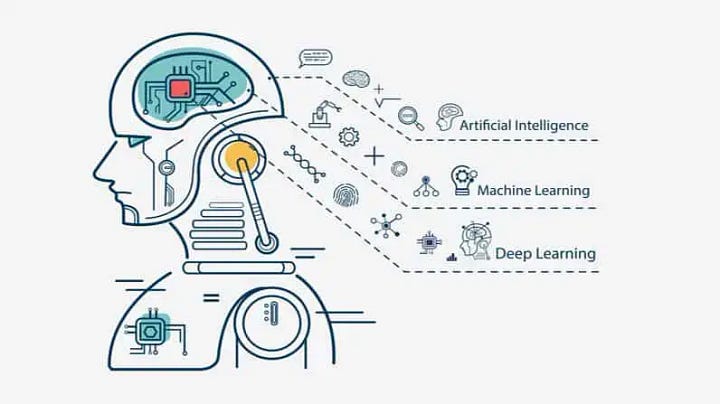In the rapidly evolving landscape of technology, few innovations have garnered as much attention and fascination as Artificial Intelligence (AI). While AI may seem like a futuristic concept, the truth is that it has already woven itself into the fabric of our daily lives often operating subtly behind the scenes. From the personalized recommendations that guide our online shopping experiences to the voice assistants that respond to our every query, AI is the unseen force propelling modern conveniences. As we embark on a quest to understand the essence of AI, we find ourselves journeying through a landscape of innovation and transformation. What exactly is AI and how has it evolved from being an inconspicuous assistant to a harmonious companion in our endeavors ?

What is Artificial Intelligence?
The concept of Artificial Intelligence encompasses a world of capabilities often unnoticed in our daily routines such as Search Engines, Product Suggestions and Speech Recognition systems.
Artificial intelligence (AI) refers to the ability of a machine to learn patterns and make predictions. AI does not replace human decisions, instead AI adds value to human judgment.
In its simplest form, artificial intelligence is a field that combines computer science and robust datasets to enable problem-solving. What do you think of AI ? Let me know in the comment section and let’s dive deeper into the layers that constitute this modern marvel.
AI journey “From Hidden Helpers to Human-Machine Harmony” suggests a transition in the perception and role of artificial intelligence (AI) over time. “Hidden Helpers” refers to the initial phase where AI technologies such as search engines, product suggestions and speech recognition systems operate in the background often unnoticed by users but playing a significant role in enhancing various aspects of daily life. “Human-Machine Harmony” refers to a later stage where AI is more integrated into human activities and functions in a collaborative and synergistic manner. This stage implies a balance and cooperation between human abilities and AI capabilities with both entities working together seamlessly to achieve tasks and goals. In short, it captures the journey of AI’s development and adoption from being inconspicuous tools to becoming integral and cooperative elements in human endeavors.
As we continue our exploration about artificial intelligence, you will come across the term Augmented Intelligence. Both terms share the same objective but have different approaches. Let us understand What is the difference between AI and Augmented Intelligence?
Artificial Intelligence Vs Augmented Intelligence
Let us understand three forms of Intelligence — Human Intelligence, Artificial Intelligence and Augmented Intelligence.
- Human Intelligence (Driving a Vehicle) : It is demonstrated during the drive as driver operates the vehicle, steering and checking mirrors.
- Artificial Intelligence (Self Driving Features) : Upon entering the highway, artificial intelligence takes over through the car’s self driving features. The vehicle maintains its lane, distance from other vehicles and speed autonomously. This form of intelligence enables machines to perform tasks that typically require human intelligence such as reasoning, problem solving and communication. AI can make decisions and execute tasks independently often integrated into various systems.
- Augmented Intelligence (Driver Assist Features) : Exiting the highway, the driver engages augmented intelligence. The car’s driver-assist features such as collision detection and blind spot avoidance augment human capabilities by alerting the driver to potential dangers. This form of intelligence involves collaboration between humans and machines. It enhances human abilities by leveraging machine capabilities to complement and amplify human strengths.

In short, Augmented intelligence has a modest goal of helping humans with tasks that are not practical to do. For example, reading 1000 pages in an hour. In contrast, artificial intelligence has a lofty goal of mimicking human thinking and processes. However, it is important to note that AI today is not mature enough to perform independent tasks such as diagnosing cancer.
Talking about the Strength Matrix, Machines Vs Humans,
- Machines excel at processing large amounts of data quickly and accurately. They perform well in repetitive tasks and tasks that demand high accuracy.
- Humans have strengths in generalizing information, creativity and emotional intelligence. They excel at understanding concepts, solving problems and navigating emotionally complex situations.
So, where does Augmented Intelligence lie ?
- Augmented Intelligence: The Sweet Spot — Augmented intelligence combines the strengths of both machines and humans. By harnessing AI to enhance human perception and understanding, augmented intelligence empowers humans to achieve feats that would not be feasible without technological assistance.
Both forms of intelligence play vital roles, with augmented intelligence serving as the harmonious collaboration between humans and machines allowing humanity to flourish and thrive.
What continues to drive the development of AI?
As computing power and algorithms become more powerful and data volumes increase, companies will adopt new use cases for AI technologies. Companies will embed smart systems into their applications to drive innovation and efficiencies, enhance employee experience, automate tasks, decrease costs and improve revenue.
What does AI do ?
Artificial intelligence machines don’t think, they calculate.
Artificial intelligence machines (researchers call them “AI services”) perform calculations rather than engaging in thinking processes. They represent some of the newest, most sophisticated calculating machines in human history. Some can perform what’s called Machine Learning as they acquire new data. Others using calculations arranged in ways inspired by neurons in the human brain can even perform Deep Learning with multiple levels of calculations.

Case : Imagine you are tasked with arranging a collection of plants in a garden. The garden is teeming with various species and you have limited time to organize them manually. How could you leverage artificial intelligence (AI), machine learning and deep learning to simplify your task?

- Artificial Intelligence: To categorize the plants into groups such as flowers, shrubs and trees, we could employ an AI system that learns from data. Instead of explicitly programming rules, the AI would analyze attributes like leaf shape, flower color and growth patterns. Over time, the system would recognize patterns and make informed decisions, adapting its categorization based on the characteristics it observes.
- Machine Learning: To enhance the system’s accuracy, we would feed it a diverse dataset containing details about each plant’s botanical features. Through machine learning, the system would iteratively refine its understanding of each species. By recognizing correlations between attributes and categories, it would become better equipped to differentiate between plants and allocate them to appropriate groups and minimizing errors through continuous learning.
- Deep Learning: Now, suppose the garden introduces new plant species with intricate variations in leaf patterns, colors and sizes. In that case, deep learning can handle such complexity seamlessly.
In the gardening scenario, we would implement deep learning algorithms to categorize plants without manually specifying distinguishing features. After exposing the model to a plethora of plant images, it would process the visual data through layers of neural networks. These layers autonomously learn complex representations of the plants, enabling accurate categorization even for the newly introduced species.
In this way, by combining artificial intelligence, machine learning and deep learning, we would create a dynamic and adaptable system that optimizes our efforts in organizing the garden’s diverse flora.
What predictions can AI make ?
Most people have a love-hate relationship with the autocorrect feature on phones or computers. What’s happening when you enter a misspelled word ? And how does the machine know to suggest a better spelling?
Simply put, the software analyzes what you have typed so far and predicts a likely correction. Your phone or computer (or its online service) has more than just a dictionary of correct spellings. It has a huge library of phrases that humans use in certain contexts on many subjects. So, when you enter a word that’s not in its dictionary, it begins analyzing and predicting and suggests the word you need. Predictions are not always accurate. But if they are correct often enough, they are useful and can save you time.
Here are more ways that AI uses data to make predictions.
- Human language: Online chatbots use natural language processing (NLP) to analyze poorly typed or spoken questions, then predict which answers to give on topics ranging from shipping or business hours to merchandise and sizes.
- Vision recognition: AI helps doctors identify serious diseases based on unusual symptoms and early-warning signs, and it reads speed limit and stop signs as it guides cars through traffic.
- Fraud detection: AI analyzes patterns created when thousands of bank customers make credit card purchases, then predicts which charges might be the result of identity theft.
How AI is evolving ?
Computer scientists have identified three levels of AI based on predicted growth in its ability to analyze data and make predictions.

1. Narrow AI: Task-Focused and Rapidly Scaling
- Narrow AI is focused on addressing a single task such as predicting your next purchase or planning your day.
- Narrow AI is scaling very quickly in the consumer world, in which there are a lot of common tasks and data to train AI systems. For example, you can buy a book with a voice-based device.
- Narrow AI also enables robust applications, such as using Siri on an iPhone, the Amazon recommendation engine, autonomous vehicles and more. Narrow AI systems like Siri have conversational capabilities, but only if you stick to the script.
2. Broad AI: Versatility and Enterprise Integration
- Broad AI is a midpoint between Narrow and General AI.
- Rather than being limited to a single task, Broad AI systems are more versatile and can handle a wider range of related tasks.
- Broad AI is focused on integrating AI within a specific business process where companies need business- and enterprise-specific knowledge and data to train this type of system.
- Newer Broad AI systems predict global weather, trace pandemics, and help businesses predict future trends.
3. General AI: The Quest for Human-Like Intellectual Abilities
- General AI refers to machines that can perform any intellectual task that a human can.
- Currently, AI does not have the ability to think abstractly, strategize, and use previous experiences to come up with new, creative ideas as humans do, such as inventing a new product or responding to people with appropriate emotions. And don’t worry, AI is nowhere near this point.
There might be another level, known as artificial superintelligence (ASI) that could appear near the end of this century. Then machines might become self-aware! Even then, no levels of AI are expected to replace or dominate you. Instead, scientists hope AI will extend humans’ ability to lead richer lives.

Narrow AI, and Broad AI are available today. In fact, most enterprises use Broad AI. General AI won’t come online until sometime in the future.
As we conclude this journey through the realms of AI, from hidden helpers to human-machine harmony, one thing is clear that AI’s potential is vast and its evolution is an ongoing narrative. As computing power surges, algorithms evolve and data volumes expand, AI’s trajectory continues upward, promising a future where human capabilities are elevated where innovation knows no bounds and where the synergy between humans and machines brings forth a new era of unparalleled possibilities.


